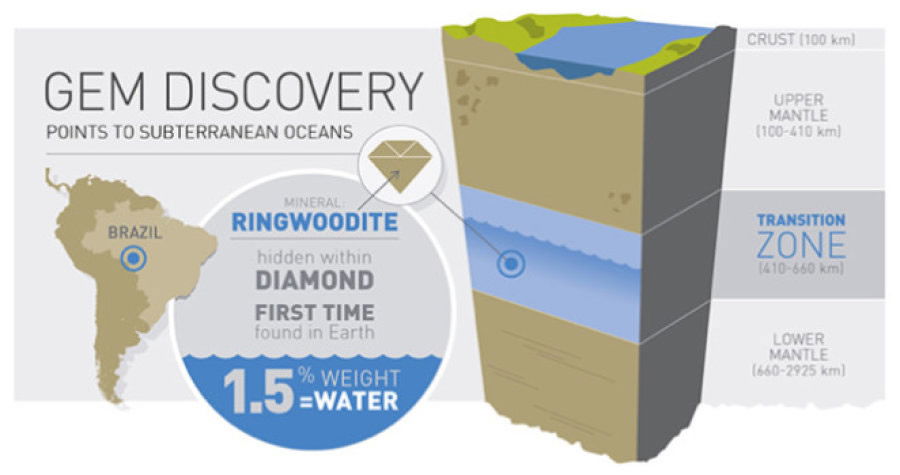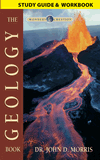
Diamond with Ringwoodite Reveals Water Deep in Earth’s Mantle
News to Know
Abstract
Discovery inside a diamond in the rough shows Jules Verne wasn’t that far off when he wrote about a hidden ocean in Journey to the Centre of the Earth.
News Source
- FOX News: “Rare Diamond Reveals Earth’s Interior Is All Wet”
More than just a place of molten rock, earth’s mantle apparently harbors a watery zone able to hold an ocean of water. Analysis of a diamond volcanically coughed up from deep in the earth and recovered in Brazilian river gravel has serendipitously revealed water-containing ringwoodite, a testimony to the presence of both water and the elusive olivine polymorph under the earth.
One Man’s Trash Is Another’s Treasure
What is ringwoodite? Certainly not a mineral found in anyone’s ordinary rock collection! Ringwoodite is an alternate crystalline form (a polymorph) of the mineral olivine—(Mg2+)2(SiO4). Until now, ringwoodite existed only in laboratories and in some meteorites thought to have been pelted with enough pressure to force the crystalline structure of olivine to assume an octahedral configuration known as a spinel structure. There is room between the atoms in this crystal lattice for a significant amount of water. The crystalline structure of ringwoodite could theoretically accommodate up to 2% water by weight.1
Discard-grade diamonds, formed where it’s much too deep to drill, are gems to geologists wishing to probe conditions deep in the earth. The tiny treasure that has given us a peek into the earth’s deep secrets is enclosed in a misshapen brownish diamond only 3 millimeters in diameter. With no commercial value, geochemists looking for a way to date diamonds purchased it from miners in the Juína region of Mato Grosso, Brazil. In the stone lurked a ringwoodite inclusion. “It's so small, this inclusion, it's extremely difficult to find, never mind work on, so it was a bit of a piece of luck, this discovery, as are many scientific discoveries,”2 says Graham Pearson, Canadian geochemist and lead author of the study published in Nature. Just finding a natural terrestrial sample of ringwoodite was a landmark event, but even more momentous is the discovery that it contains about 1.5 weight% water. The discovery confirms a couple of theories about the composition of earth’s mantle.

This misshapen diamond discard, only 3 mm across, contains an even smaller bit of ringwoodite (as indicated), the first terrestrial sample ever discovered. Ringwoodite is a form of olivine but only forms under intense pressure, such as that exerted by 320 miles of overlying mantle. Image by Richard Siemens, via Nature.3
Ringwoodite was named after Australian geologist Alfred Ringwood. He first theorized the possibility that certain variations in the speed of seismic waves in the mantle were caused by the presence of an olivine polymorph. Olivine comprises much of the upper mantle, and Ringwood suggested that a polymorph of olivine formed by the intense pressure beneath 320 miles of mantle could create the observed discontinuities in seismic waves. This transition zone between the upper and lower mantle, 255 to 410 miles under the earth, cannot be reached, so the presence of ringwoodite in it, until this surprising sample surfaced, was strongly suspected but unproven.
Answers in Genesis geologist, Dr. Andrew Snelling explains:
For a long time it has been known that the upper mantle is made up predominantly of the mineral olivine (Mg2 SiO4), but its lattice structure can’t hold much water within it. Experimental work had demonstrated that at pressures deeper in the mantle, between 410 km and 660 km (255–410 miles), as determined by seismic studies, the higher-pressure equivalent (polymorph) of olivine that was named ringwoodite must exist. However, no naturally occurring ringwoodite had been found.
Water in the Rock
Pearson’s team confirmed that ringwoodite, due to its crystalline structure, is able to hold a great deal more water than common forms of olivine, between 1 and 2 weight%. “Now that might not sound like a lot of water,” Dr. Snelling explains, “but when one takes into account the volume of this zone in the mantle, there could be at least as much water stored there as in all the world’s oceans.” If this sample is truly representative of the lowermost part of the mantle transition zone (between 520 and 660 kilometers) where ringwoodite should be most stable, that portion of earth’s mantle alone could be holding 1.4 x 1021 kilograms of water, which is equivalent to the mass of all the water in all the world’s oceans combined.4

This is a synthetic blue ringwoodite crystal. It is only 150 nanometers across. Until the recent discovery of ringwoodite in a Brazilian diamond, no ringwoodite had ever been recovered from terrestrial sources, only meteorites. Image by Jasperox, via Wikipedia Commons.
Water is trapped in ringwoodite, not as liquid, but in the form of hydroxide ions. Nevertheless, says Pearson, “It's actually the confirmation that there is a very, very large amount of water that's trapped in a really distinct layer in the deep Earth.” Though not in liquid form, Pearson says, “It translates into a very, very large mass of water.”
Though the proof has been lacking, geologic models have suggested that water should be present in the mantle. Slabs of ocean-soaked crust sink into subduction zones through the process of plate tectonics, so it makes sense that this material sinking into the mantle could carry water with it. “We think that a significant portion of the water in the mantle transition zone is from the emplacement of these slabs,” Pearson explains. “The transition zone seems to be a graveyard of subducted slabs.”
Was this “wet” bit of “rock” the exception or the rule? It’s too early to tell. Hopefully, now that they know to look for it, geochemists will find more such gifts from deep in the mantle and find out whether they too contain water. “One of the reasons the Earth is such a dynamic planet is the presence of some water in its interior,” Pearson says. “Water changes everything about the way a planet works.”5
Fountains of the Great Deep
As we examine this discovery in light of the history of the global Flood documented in God’s Word, we see that water not only changes everything about the way a planet works in the present, but also about 4,300 years ago at the time of the global Flood. Dr. Snelling explains:
What is the profound significance of this discovery? It confirms the capacity of the mantle to have housed the water that was released when the fountains of the great deep were broken up to commence the Flood, and the huge volume of water that was released through these fountains for as much as 150 days, providing more than enough water to help submerge the whole globe, just as described in Genesis 7:11–24.
Rocketing Ringwoodite
Pearson’s research team did not heat polish their diamond discard as is normally done prior to analysis. Because heat transforms ringwoodite to other forms, the omission of this step may be largely responsible for the preservation of ringwoodite in the sample. “We think it's possible ringwoodite may have been found by other researchers before,” explains Pearson, “but the way they prepared their samples caused it to change back to a lower-pressure form.”
Even though ringwoodite has long been believed present in the mantle transition zone, no one really expected to find it even in diamonds from deep in the earth.
Even though ringwoodite has long been believed present in the mantle transition zone, no one really expected to find it even in diamonds from deep in the earth. Why? Because it was thought that the trip to the surface, with decreasing pressures, would permit any ringwoodite to morph back into olivine’s common crystalline structure. “Most people (including me) never expected to see such a sample,” observes German geochemist Hans Kepler in a Nature “News and Views” column. For this reason, Pearson’s team strongly suspects this little diamond’s trip to the surface must have been explosively rapid.
The ugly duckling of a diamond, as shown in the photograph, bears the scars of its violent 325-mile journey from so deep in the earth’s mantle. Geologists believe that “kimberlite” magma rich in volatile components like water and carbon dioxide feeds the extremely explosive volcanic explosions needed to make the earth cough up diamonds from the ultradeep region where ringwoodite could exist.6 “The eruption of a kimberlite is analogous to dropping a Mentos mint into a bottle of soda. It's a very energetic, gas-charged reaction that blasts its way to Earth's surface,” Pearson explains, so misshapen diamonds like this “literally look like they've been to hell and back.”

The first naturally formed terrestrial sample of ringwoodite, found in a diamond formed deep in the earth’s mantle, not only demonstrates the presence of ringwoodite—long suspected of causing discontinuities in seismic waves—but also confirms the presence of water in the mantle transition zone. Image by University of Alberta, via ScienceDaily.7
Catastrophic Plate Tectonics
Pearson’s conclusions about the explosive rapid transit that delivered the little diamond to the surface also have implications for our understanding of geological events at the time of the global Flood. Dr. Snelling says:
Interestingly this study also concluded that the diamond hosting this ringwoodite inclusion must also have come from the 410–660 km zone. This in turn means that the explosive volcanism responsible for blasting diamonds in volcanic rocks into the earth’s upper crust and even to the surface within a matter of hours, must have in at least some instances started from this 410–660 km zone. Similar explosive volcanism could therefore have potentially been responsible for releasing and catapulting water from this deep mantle storage reservoir up to the earth’s surface during the Flood.
So this study seems to confirm a major component of the catastrophic plate tectonics model. The break-up of the earth’s crust into plates and the resultant continental sprint was initiated by the cataclysmic release of the waters for the Flood through these fountains of the great deep.

As slabs of earth’s crust from the ocean bottoms sink (through subduction) into the mantle they carry water with them. Could the water that thus enters the mantle be stored in the crystalline structure of minerals such as ringwoodite, a form of the olivine that only forms under extreme pressure? A miniscule bit of ringwoodite found in a diamond thought to have come from the mantle transition zone reveals the answer is yes. Image by Kathy Mather, via Yahoo.com.8
Though we were not there at the time of the global Flood, God in His Word, primarily in Genesis chapters 6–9, has provided us with an eyewitness account of the violent events that remodeled the earth’s surface. The geology we see today has been strongly influenced by the global Flood, and Bible-believing geologists like Dr. Snelling note that what we see is consistent with biblical history. The Bible’s history helps us understand what we see in nature and to understand that our world did not require billions of years to take its present shape. This latest discovery is likewise completely consistent with biblical history.
Further Reading
- Diamonds—Evidence of Explosive Geological Processes
- Journey to the Center of the Earth
- Does the Secret of the Earth’s Origin Abide in the Planet’s Core?
- A Catastrophic Breakup
- Can Catastrophic Plate Tectonics Explain Flood Geology?
- Catastrophic Plate Tectonics: A Global Flood Model of Earth History
- Catastrophic Plate Tectonics: the Geophysical Context of the Genesis Flood
- Get Answers
For More Information: Get Answers
Remember, if you see a news story that might merit some attention, let us know about it! (Note: if the story originates from the Associated Press, FOX News, MSNBC, the New York Times, or another major national media outlet, we will most likely have already heard about it.) And thanks to all of our readers who have submitted great news tips to us. If you didn’t catch all the latest News to Know, why not take a look to see what you’ve missed?
(Please note that links will take you directly to the source. Answers in Genesis is not responsible for content on the websites to which we refer. For more information, please see our Privacy Policy.)
Footnotes
- Kepler, “Earth’s Deep Water Reservoir.”
- University of Alberta, “Water-Rich Gem Points to Vast ‘Oceans’ Beneath Earth’s Surface, Study Suggests.”
- Richard Siemens, University of Alberta, in “Earth’s Deep Water Reservoir,” Nature 507 (March 13, 2014): 174–175, doi:10.1038/507174a.
- Kepler, “Earth’s Deep Water Reservoir.”
- University of Alberta, “Water-Rich Gem Points to Vast ‘Oceans’ Beneath Earth’s Surface, Study Suggests.”
- Kepler, “Earth’s Deep Water Reservoir.
- University of Alberta, “Water-Rich Gem Points to Vast ‘Oceans’ Beneath Earth’s Surface, Study Suggests,” ScienceDaily, March 12, 2014, http://www.sciencedaily.com/releases/2014/03/140312150229.htm.
- Becky Oskin, “Rare Diamond Reveals Earth’s Interior Is All Wet,” Yahoo! News, March 12, 2014, https://www.yahoo.com/news/rare-diamond-reveals-earths-interior-wet-181429521.html?ref=gs.
Recommended Resources

Answers in Genesis is an apologetics ministry, dedicated to helping Christians defend their faith and proclaim the good news of Jesus Christ.
- Customer Service 800.778.3390
- Available Monday–Friday | 9 AM–5 PM ET
- © 2025 Answers in Genesis





